Case Study Report: Woolworths - Management Perspectives Analysis
VerifiedAdded on 2023/01/12
|11
|2486
|64
Case Study
AI Summary
This case study report examines Woolworths, an Australian grocery store, focusing on its organizational theory, ethics, and management practices. The report delves into the company's vision, values, and organizational structure, including its approach to motivation, leadership, and communication. It analyzes the application of organizational theories such as Agency theory and Sense making theory within Woolworths. The study highlights Woolworths' commitment to corporate social responsibility (CSR) through its diversity initiatives, ethical practices, and efforts to support various communities. The report evaluates the company's strengths and weaknesses concerning diversity, particularly concerning the LGBTI community, and assesses its efforts to foster an inclusive and equitable work environment. The analysis includes an examination of Woolworths' sustainability reports and the integration of its values into its organizational culture, providing insights into the company's approach to management and its impact on employees and customers. The conclusion emphasizes the importance of open communication, employee motivation, and diversity in fostering a successful organizational culture.

MANAGEMENT PERSPECTIVES
Paraphrase This Document
Need a fresh take? Get an instant paraphrase of this document with our AI Paraphraser
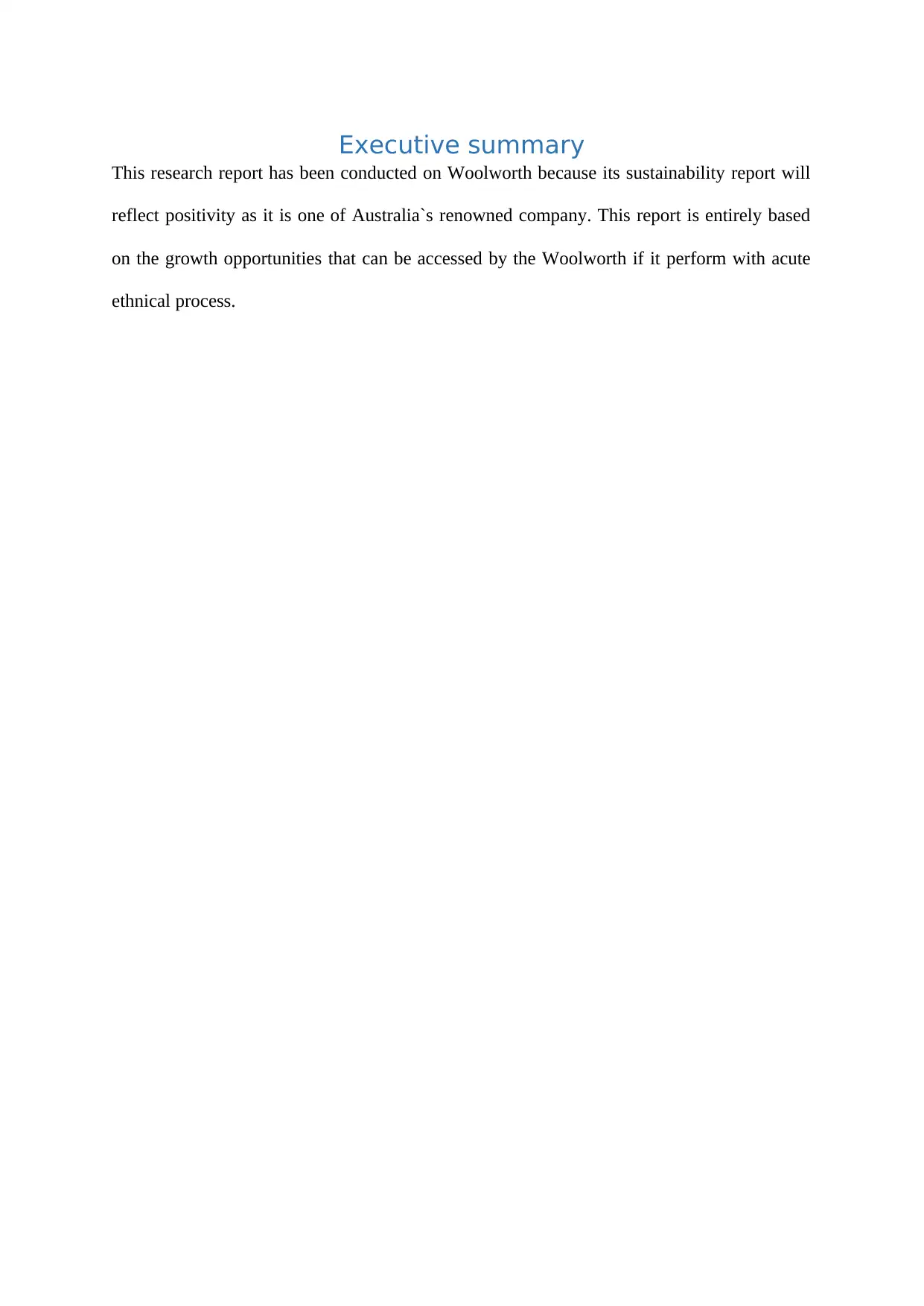
Executive summary
This research report has been conducted on Woolworth because its sustainability report will
reflect positivity as it is one of Australia`s renowned company. This report is entirely based
on the growth opportunities that can be accessed by the Woolworth if it perform with acute
ethnical process.
This research report has been conducted on Woolworth because its sustainability report will
reflect positivity as it is one of Australia`s renowned company. This report is entirely based
on the growth opportunities that can be accessed by the Woolworth if it perform with acute
ethnical process.
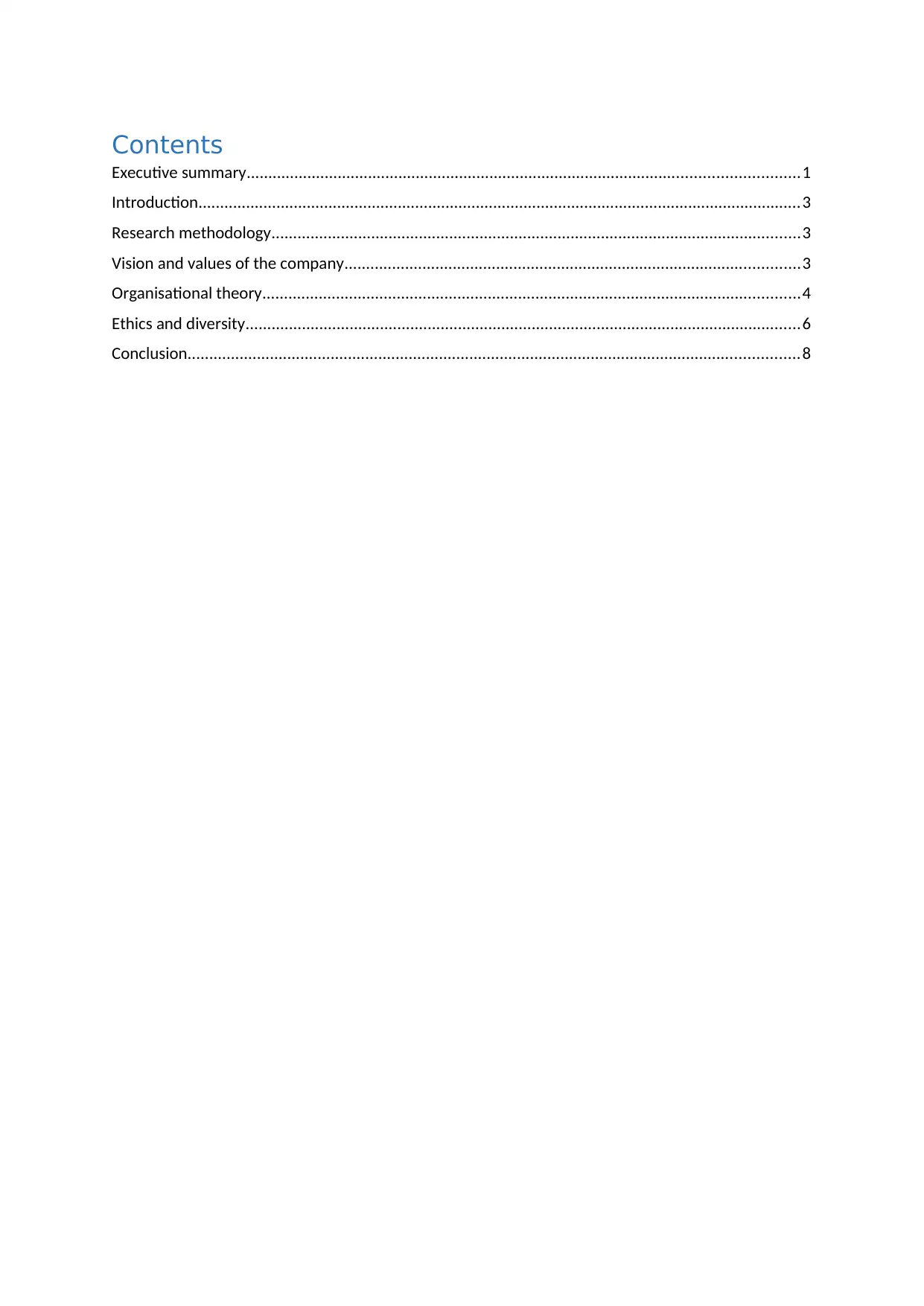
Contents
Executive summary...............................................................................................................................1
Introduction...........................................................................................................................................3
Research methodology..........................................................................................................................3
Vision and values of the company.........................................................................................................3
Organisational theory............................................................................................................................4
Ethics and diversity................................................................................................................................6
Conclusion.............................................................................................................................................8
Executive summary...............................................................................................................................1
Introduction...........................................................................................................................................3
Research methodology..........................................................................................................................3
Vision and values of the company.........................................................................................................3
Organisational theory............................................................................................................................4
Ethics and diversity................................................................................................................................6
Conclusion.............................................................................................................................................8
⊘ This is a preview!⊘
Do you want full access?
Subscribe today to unlock all pages.

Trusted by 1+ million students worldwide
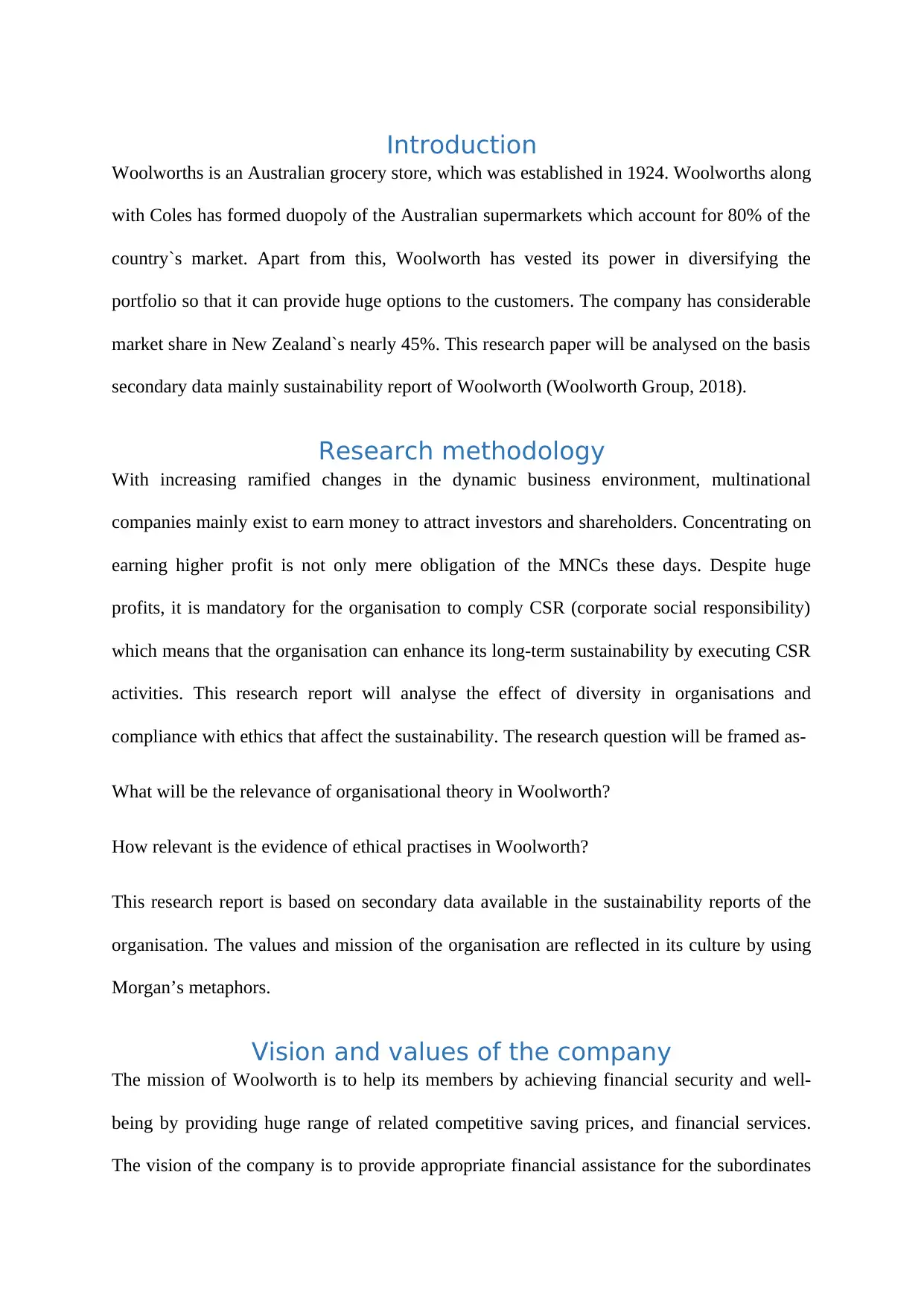
Introduction
Woolworths is an Australian grocery store, which was established in 1924. Woolworths along
with Coles has formed duopoly of the Australian supermarkets which account for 80% of the
country`s market. Apart from this, Woolworth has vested its power in diversifying the
portfolio so that it can provide huge options to the customers. The company has considerable
market share in New Zealand`s nearly 45%. This research paper will be analysed on the basis
secondary data mainly sustainability report of Woolworth (Woolworth Group, 2018).
Research methodology
With increasing ramified changes in the dynamic business environment, multinational
companies mainly exist to earn money to attract investors and shareholders. Concentrating on
earning higher profit is not only mere obligation of the MNCs these days. Despite huge
profits, it is mandatory for the organisation to comply CSR (corporate social responsibility)
which means that the organisation can enhance its long-term sustainability by executing CSR
activities. This research report will analyse the effect of diversity in organisations and
compliance with ethics that affect the sustainability. The research question will be framed as-
What will be the relevance of organisational theory in Woolworth?
How relevant is the evidence of ethical practises in Woolworth?
This research report is based on secondary data available in the sustainability reports of the
organisation. The values and mission of the organisation are reflected in its culture by using
Morgan’s metaphors.
Vision and values of the company
The mission of Woolworth is to help its members by achieving financial security and well-
being by providing huge range of related competitive saving prices, and financial services.
The vision of the company is to provide appropriate financial assistance for the subordinates
Woolworths is an Australian grocery store, which was established in 1924. Woolworths along
with Coles has formed duopoly of the Australian supermarkets which account for 80% of the
country`s market. Apart from this, Woolworth has vested its power in diversifying the
portfolio so that it can provide huge options to the customers. The company has considerable
market share in New Zealand`s nearly 45%. This research paper will be analysed on the basis
secondary data mainly sustainability report of Woolworth (Woolworth Group, 2018).
Research methodology
With increasing ramified changes in the dynamic business environment, multinational
companies mainly exist to earn money to attract investors and shareholders. Concentrating on
earning higher profit is not only mere obligation of the MNCs these days. Despite huge
profits, it is mandatory for the organisation to comply CSR (corporate social responsibility)
which means that the organisation can enhance its long-term sustainability by executing CSR
activities. This research report will analyse the effect of diversity in organisations and
compliance with ethics that affect the sustainability. The research question will be framed as-
What will be the relevance of organisational theory in Woolworth?
How relevant is the evidence of ethical practises in Woolworth?
This research report is based on secondary data available in the sustainability reports of the
organisation. The values and mission of the organisation are reflected in its culture by using
Morgan’s metaphors.
Vision and values of the company
The mission of Woolworth is to help its members by achieving financial security and well-
being by providing huge range of related competitive saving prices, and financial services.
The vision of the company is to provide appropriate financial assistance for the subordinates
Paraphrase This Document
Need a fresh take? Get an instant paraphrase of this document with our AI Paraphraser
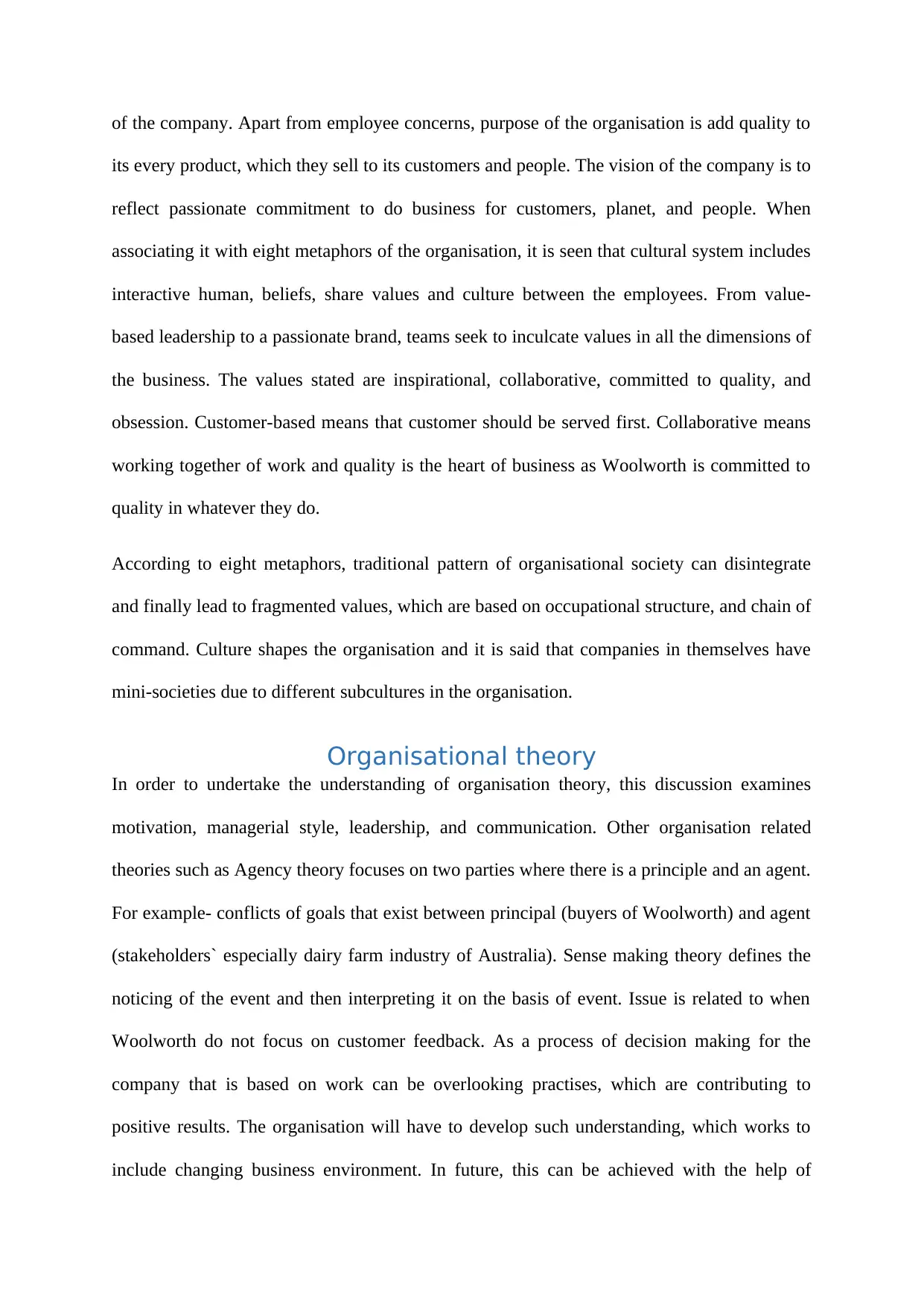
of the company. Apart from employee concerns, purpose of the organisation is add quality to
its every product, which they sell to its customers and people. The vision of the company is to
reflect passionate commitment to do business for customers, planet, and people. When
associating it with eight metaphors of the organisation, it is seen that cultural system includes
interactive human, beliefs, share values and culture between the employees. From value-
based leadership to a passionate brand, teams seek to inculcate values in all the dimensions of
the business. The values stated are inspirational, collaborative, committed to quality, and
obsession. Customer-based means that customer should be served first. Collaborative means
working together of work and quality is the heart of business as Woolworth is committed to
quality in whatever they do.
According to eight metaphors, traditional pattern of organisational society can disintegrate
and finally lead to fragmented values, which are based on occupational structure, and chain of
command. Culture shapes the organisation and it is said that companies in themselves have
mini-societies due to different subcultures in the organisation.
Organisational theory
In order to undertake the understanding of organisation theory, this discussion examines
motivation, managerial style, leadership, and communication. Other organisation related
theories such as Agency theory focuses on two parties where there is a principle and an agent.
For example- conflicts of goals that exist between principal (buyers of Woolworth) and agent
(stakeholders` especially dairy farm industry of Australia). Sense making theory defines the
noticing of the event and then interpreting it on the basis of event. Issue is related to when
Woolworth do not focus on customer feedback. As a process of decision making for the
company that is based on work can be overlooking practises, which are contributing to
positive results. The organisation will have to develop such understanding, which works to
include changing business environment. In future, this can be achieved with the help of
its every product, which they sell to its customers and people. The vision of the company is to
reflect passionate commitment to do business for customers, planet, and people. When
associating it with eight metaphors of the organisation, it is seen that cultural system includes
interactive human, beliefs, share values and culture between the employees. From value-
based leadership to a passionate brand, teams seek to inculcate values in all the dimensions of
the business. The values stated are inspirational, collaborative, committed to quality, and
obsession. Customer-based means that customer should be served first. Collaborative means
working together of work and quality is the heart of business as Woolworth is committed to
quality in whatever they do.
According to eight metaphors, traditional pattern of organisational society can disintegrate
and finally lead to fragmented values, which are based on occupational structure, and chain of
command. Culture shapes the organisation and it is said that companies in themselves have
mini-societies due to different subcultures in the organisation.
Organisational theory
In order to undertake the understanding of organisation theory, this discussion examines
motivation, managerial style, leadership, and communication. Other organisation related
theories such as Agency theory focuses on two parties where there is a principle and an agent.
For example- conflicts of goals that exist between principal (buyers of Woolworth) and agent
(stakeholders` especially dairy farm industry of Australia). Sense making theory defines the
noticing of the event and then interpreting it on the basis of event. Issue is related to when
Woolworth do not focus on customer feedback. As a process of decision making for the
company that is based on work can be overlooking practises, which are contributing to
positive results. The organisation will have to develop such understanding, which works to
include changing business environment. In future, this can be achieved with the help of
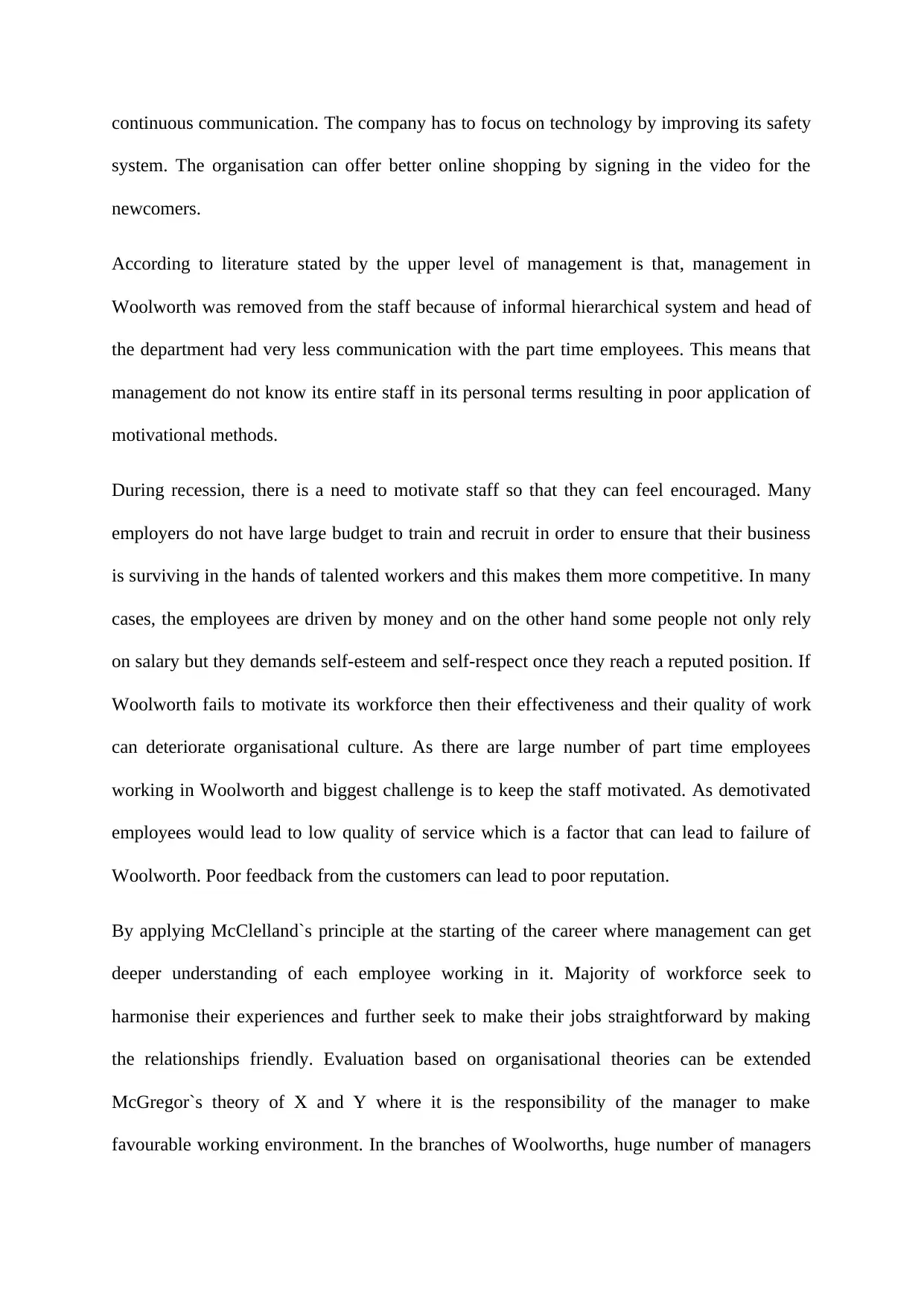
continuous communication. The company has to focus on technology by improving its safety
system. The organisation can offer better online shopping by signing in the video for the
newcomers.
According to literature stated by the upper level of management is that, management in
Woolworth was removed from the staff because of informal hierarchical system and head of
the department had very less communication with the part time employees. This means that
management do not know its entire staff in its personal terms resulting in poor application of
motivational methods.
During recession, there is a need to motivate staff so that they can feel encouraged. Many
employers do not have large budget to train and recruit in order to ensure that their business
is surviving in the hands of talented workers and this makes them more competitive. In many
cases, the employees are driven by money and on the other hand some people not only rely
on salary but they demands self-esteem and self-respect once they reach a reputed position. If
Woolworth fails to motivate its workforce then their effectiveness and their quality of work
can deteriorate organisational culture. As there are large number of part time employees
working in Woolworth and biggest challenge is to keep the staff motivated. As demotivated
employees would lead to low quality of service which is a factor that can lead to failure of
Woolworth. Poor feedback from the customers can lead to poor reputation.
By applying McClelland`s principle at the starting of the career where management can get
deeper understanding of each employee working in it. Majority of workforce seek to
harmonise their experiences and further seek to make their jobs straightforward by making
the relationships friendly. Evaluation based on organisational theories can be extended
McGregor`s theory of X and Y where it is the responsibility of the manager to make
favourable working environment. In the branches of Woolworths, huge number of managers
system. The organisation can offer better online shopping by signing in the video for the
newcomers.
According to literature stated by the upper level of management is that, management in
Woolworth was removed from the staff because of informal hierarchical system and head of
the department had very less communication with the part time employees. This means that
management do not know its entire staff in its personal terms resulting in poor application of
motivational methods.
During recession, there is a need to motivate staff so that they can feel encouraged. Many
employers do not have large budget to train and recruit in order to ensure that their business
is surviving in the hands of talented workers and this makes them more competitive. In many
cases, the employees are driven by money and on the other hand some people not only rely
on salary but they demands self-esteem and self-respect once they reach a reputed position. If
Woolworth fails to motivate its workforce then their effectiveness and their quality of work
can deteriorate organisational culture. As there are large number of part time employees
working in Woolworth and biggest challenge is to keep the staff motivated. As demotivated
employees would lead to low quality of service which is a factor that can lead to failure of
Woolworth. Poor feedback from the customers can lead to poor reputation.
By applying McClelland`s principle at the starting of the career where management can get
deeper understanding of each employee working in it. Majority of workforce seek to
harmonise their experiences and further seek to make their jobs straightforward by making
the relationships friendly. Evaluation based on organisational theories can be extended
McGregor`s theory of X and Y where it is the responsibility of the manager to make
favourable working environment. In the branches of Woolworths, huge number of managers
⊘ This is a preview!⊘
Do you want full access?
Subscribe today to unlock all pages.

Trusted by 1+ million students worldwide
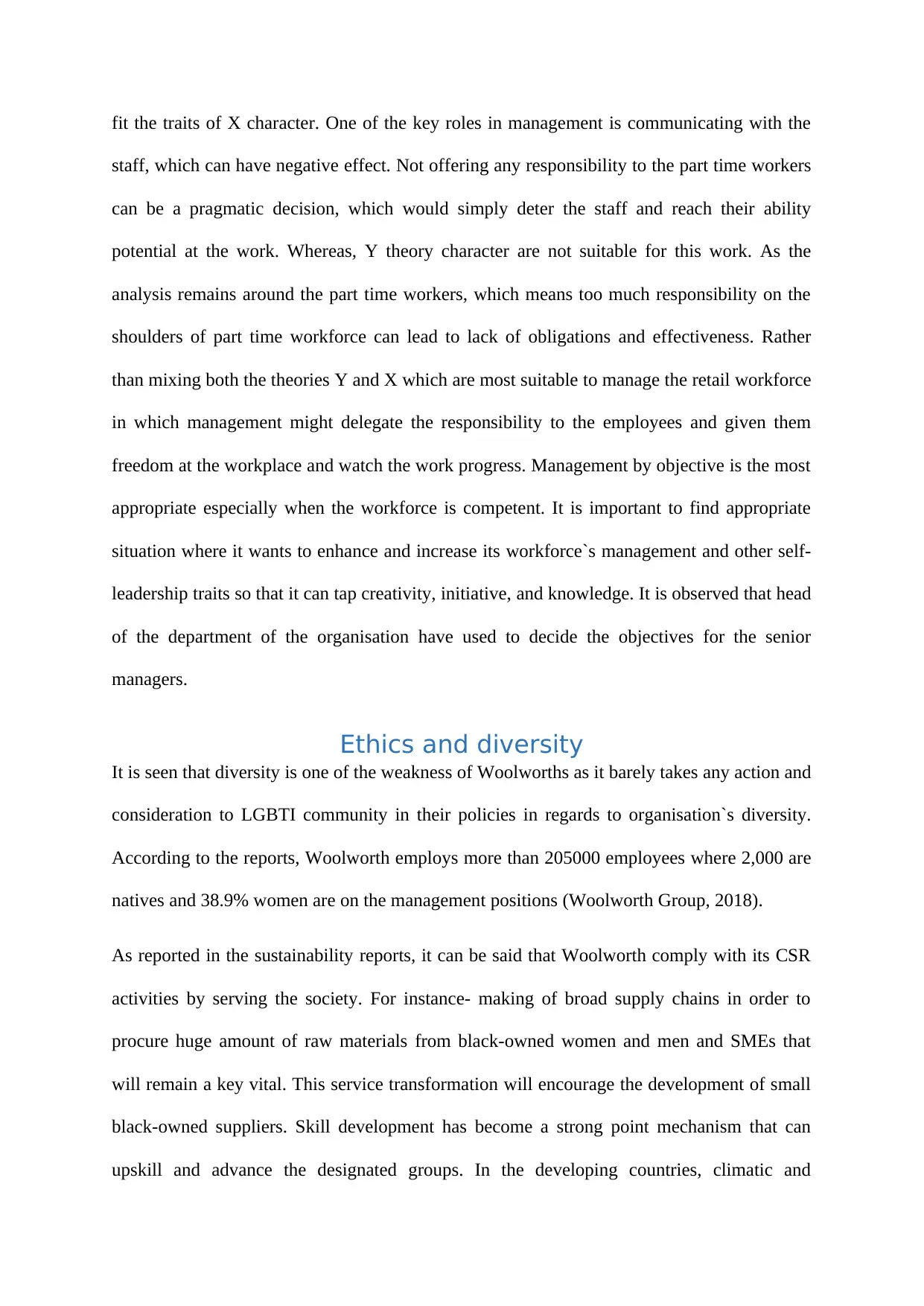
fit the traits of X character. One of the key roles in management is communicating with the
staff, which can have negative effect. Not offering any responsibility to the part time workers
can be a pragmatic decision, which would simply deter the staff and reach their ability
potential at the work. Whereas, Y theory character are not suitable for this work. As the
analysis remains around the part time workers, which means too much responsibility on the
shoulders of part time workforce can lead to lack of obligations and effectiveness. Rather
than mixing both the theories Y and X which are most suitable to manage the retail workforce
in which management might delegate the responsibility to the employees and given them
freedom at the workplace and watch the work progress. Management by objective is the most
appropriate especially when the workforce is competent. It is important to find appropriate
situation where it wants to enhance and increase its workforce`s management and other self-
leadership traits so that it can tap creativity, initiative, and knowledge. It is observed that head
of the department of the organisation have used to decide the objectives for the senior
managers.
Ethics and diversity
It is seen that diversity is one of the weakness of Woolworths as it barely takes any action and
consideration to LGBTI community in their policies in regards to organisation`s diversity.
According to the reports, Woolworth employs more than 205000 employees where 2,000 are
natives and 38.9% women are on the management positions (Woolworth Group, 2018).
As reported in the sustainability reports, it can be said that Woolworth comply with its CSR
activities by serving the society. For instance- making of broad supply chains in order to
procure huge amount of raw materials from black-owned women and men and SMEs that
will remain a key vital. This service transformation will encourage the development of small
black-owned suppliers. Skill development has become a strong point mechanism that can
upskill and advance the designated groups. In the developing countries, climatic and
staff, which can have negative effect. Not offering any responsibility to the part time workers
can be a pragmatic decision, which would simply deter the staff and reach their ability
potential at the work. Whereas, Y theory character are not suitable for this work. As the
analysis remains around the part time workers, which means too much responsibility on the
shoulders of part time workforce can lead to lack of obligations and effectiveness. Rather
than mixing both the theories Y and X which are most suitable to manage the retail workforce
in which management might delegate the responsibility to the employees and given them
freedom at the workplace and watch the work progress. Management by objective is the most
appropriate especially when the workforce is competent. It is important to find appropriate
situation where it wants to enhance and increase its workforce`s management and other self-
leadership traits so that it can tap creativity, initiative, and knowledge. It is observed that head
of the department of the organisation have used to decide the objectives for the senior
managers.
Ethics and diversity
It is seen that diversity is one of the weakness of Woolworths as it barely takes any action and
consideration to LGBTI community in their policies in regards to organisation`s diversity.
According to the reports, Woolworth employs more than 205000 employees where 2,000 are
natives and 38.9% women are on the management positions (Woolworth Group, 2018).
As reported in the sustainability reports, it can be said that Woolworth comply with its CSR
activities by serving the society. For instance- making of broad supply chains in order to
procure huge amount of raw materials from black-owned women and men and SMEs that
will remain a key vital. This service transformation will encourage the development of small
black-owned suppliers. Skill development has become a strong point mechanism that can
upskill and advance the designated groups. In the developing countries, climatic and
Paraphrase This Document
Need a fresh take? Get an instant paraphrase of this document with our AI Paraphraser
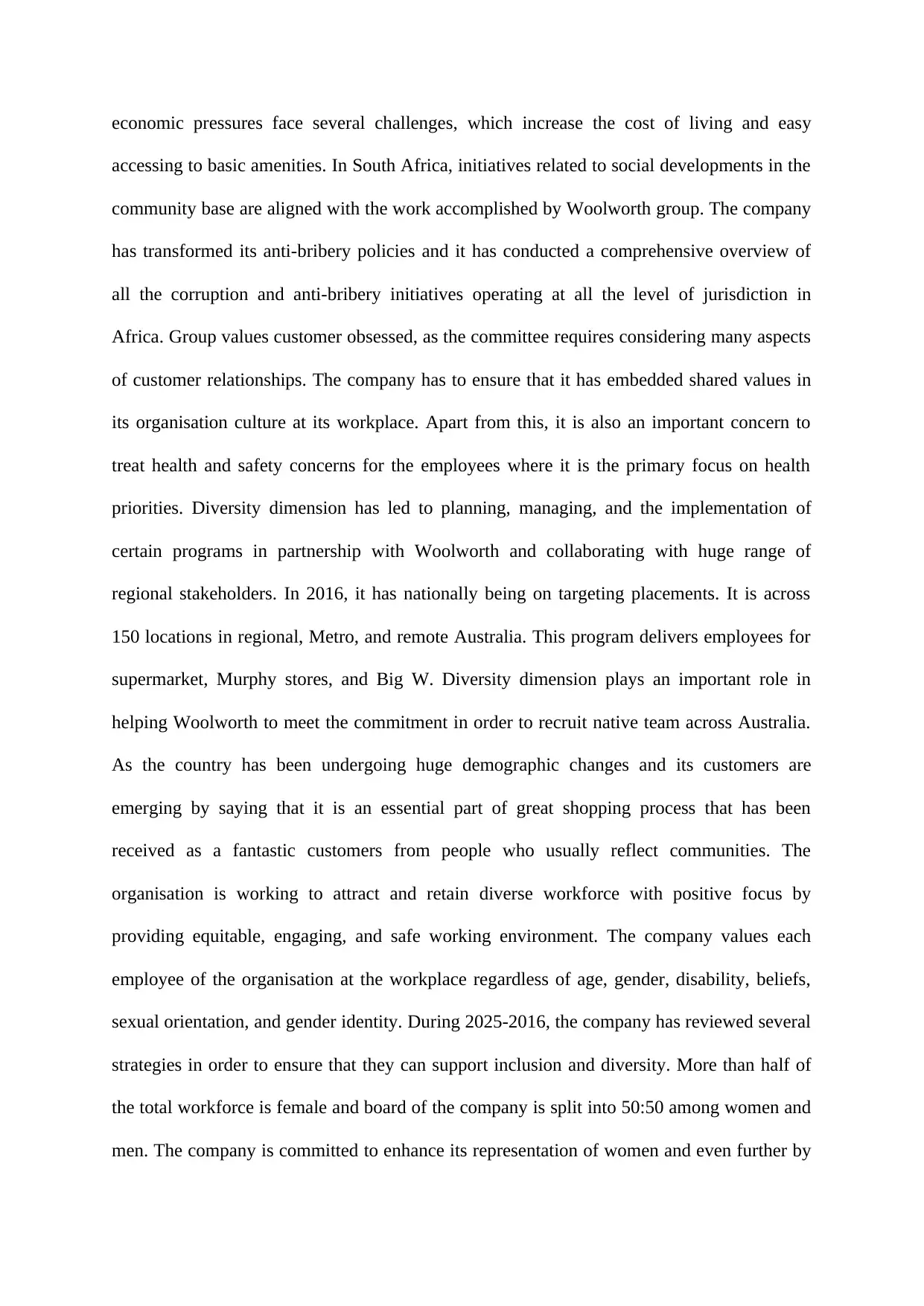
economic pressures face several challenges, which increase the cost of living and easy
accessing to basic amenities. In South Africa, initiatives related to social developments in the
community base are aligned with the work accomplished by Woolworth group. The company
has transformed its anti-bribery policies and it has conducted a comprehensive overview of
all the corruption and anti-bribery initiatives operating at all the level of jurisdiction in
Africa. Group values customer obsessed, as the committee requires considering many aspects
of customer relationships. The company has to ensure that it has embedded shared values in
its organisation culture at its workplace. Apart from this, it is also an important concern to
treat health and safety concerns for the employees where it is the primary focus on health
priorities. Diversity dimension has led to planning, managing, and the implementation of
certain programs in partnership with Woolworth and collaborating with huge range of
regional stakeholders. In 2016, it has nationally being on targeting placements. It is across
150 locations in regional, Metro, and remote Australia. This program delivers employees for
supermarket, Murphy stores, and Big W. Diversity dimension plays an important role in
helping Woolworth to meet the commitment in order to recruit native team across Australia.
As the country has been undergoing huge demographic changes and its customers are
emerging by saying that it is an essential part of great shopping process that has been
received as a fantastic customers from people who usually reflect communities. The
organisation is working to attract and retain diverse workforce with positive focus by
providing equitable, engaging, and safe working environment. The company values each
employee of the organisation at the workplace regardless of age, gender, disability, beliefs,
sexual orientation, and gender identity. During 2025-2016, the company has reviewed several
strategies in order to ensure that they can support inclusion and diversity. More than half of
the total workforce is female and board of the company is split into 50:50 among women and
men. The company is committed to enhance its representation of women and even further by
accessing to basic amenities. In South Africa, initiatives related to social developments in the
community base are aligned with the work accomplished by Woolworth group. The company
has transformed its anti-bribery policies and it has conducted a comprehensive overview of
all the corruption and anti-bribery initiatives operating at all the level of jurisdiction in
Africa. Group values customer obsessed, as the committee requires considering many aspects
of customer relationships. The company has to ensure that it has embedded shared values in
its organisation culture at its workplace. Apart from this, it is also an important concern to
treat health and safety concerns for the employees where it is the primary focus on health
priorities. Diversity dimension has led to planning, managing, and the implementation of
certain programs in partnership with Woolworth and collaborating with huge range of
regional stakeholders. In 2016, it has nationally being on targeting placements. It is across
150 locations in regional, Metro, and remote Australia. This program delivers employees for
supermarket, Murphy stores, and Big W. Diversity dimension plays an important role in
helping Woolworth to meet the commitment in order to recruit native team across Australia.
As the country has been undergoing huge demographic changes and its customers are
emerging by saying that it is an essential part of great shopping process that has been
received as a fantastic customers from people who usually reflect communities. The
organisation is working to attract and retain diverse workforce with positive focus by
providing equitable, engaging, and safe working environment. The company values each
employee of the organisation at the workplace regardless of age, gender, disability, beliefs,
sexual orientation, and gender identity. During 2025-2016, the company has reviewed several
strategies in order to ensure that they can support inclusion and diversity. More than half of
the total workforce is female and board of the company is split into 50:50 among women and
men. The company is committed to enhance its representation of women and even further by
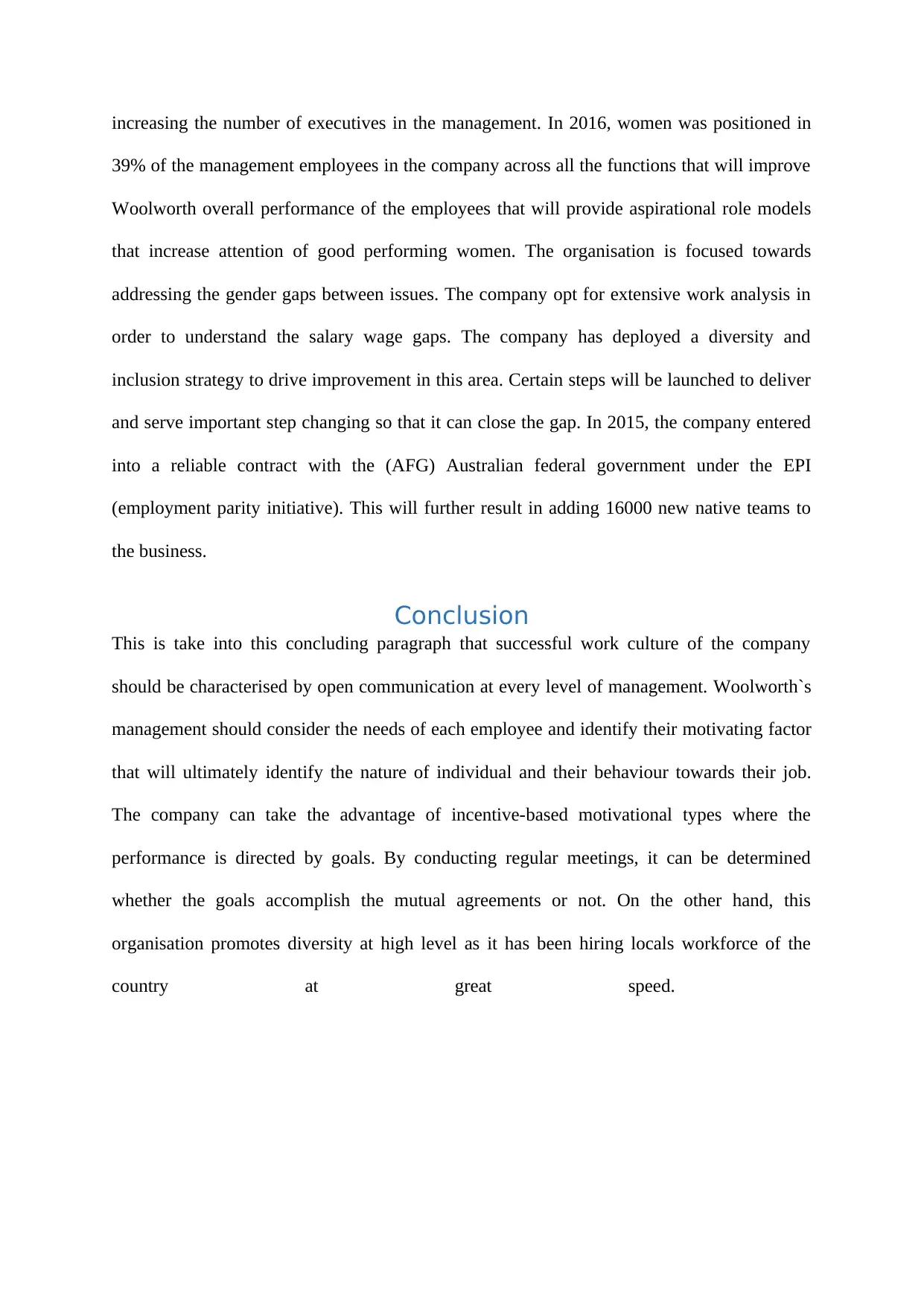
increasing the number of executives in the management. In 2016, women was positioned in
39% of the management employees in the company across all the functions that will improve
Woolworth overall performance of the employees that will provide aspirational role models
that increase attention of good performing women. The organisation is focused towards
addressing the gender gaps between issues. The company opt for extensive work analysis in
order to understand the salary wage gaps. The company has deployed a diversity and
inclusion strategy to drive improvement in this area. Certain steps will be launched to deliver
and serve important step changing so that it can close the gap. In 2015, the company entered
into a reliable contract with the (AFG) Australian federal government under the EPI
(employment parity initiative). This will further result in adding 16000 new native teams to
the business.
Conclusion
This is take into this concluding paragraph that successful work culture of the company
should be characterised by open communication at every level of management. Woolworth`s
management should consider the needs of each employee and identify their motivating factor
that will ultimately identify the nature of individual and their behaviour towards their job.
The company can take the advantage of incentive-based motivational types where the
performance is directed by goals. By conducting regular meetings, it can be determined
whether the goals accomplish the mutual agreements or not. On the other hand, this
organisation promotes diversity at high level as it has been hiring locals workforce of the
country at great speed.
39% of the management employees in the company across all the functions that will improve
Woolworth overall performance of the employees that will provide aspirational role models
that increase attention of good performing women. The organisation is focused towards
addressing the gender gaps between issues. The company opt for extensive work analysis in
order to understand the salary wage gaps. The company has deployed a diversity and
inclusion strategy to drive improvement in this area. Certain steps will be launched to deliver
and serve important step changing so that it can close the gap. In 2015, the company entered
into a reliable contract with the (AFG) Australian federal government under the EPI
(employment parity initiative). This will further result in adding 16000 new native teams to
the business.
Conclusion
This is take into this concluding paragraph that successful work culture of the company
should be characterised by open communication at every level of management. Woolworth`s
management should consider the needs of each employee and identify their motivating factor
that will ultimately identify the nature of individual and their behaviour towards their job.
The company can take the advantage of incentive-based motivational types where the
performance is directed by goals. By conducting regular meetings, it can be determined
whether the goals accomplish the mutual agreements or not. On the other hand, this
organisation promotes diversity at high level as it has been hiring locals workforce of the
country at great speed.
⊘ This is a preview!⊘
Do you want full access?
Subscribe today to unlock all pages.

Trusted by 1+ million students worldwide
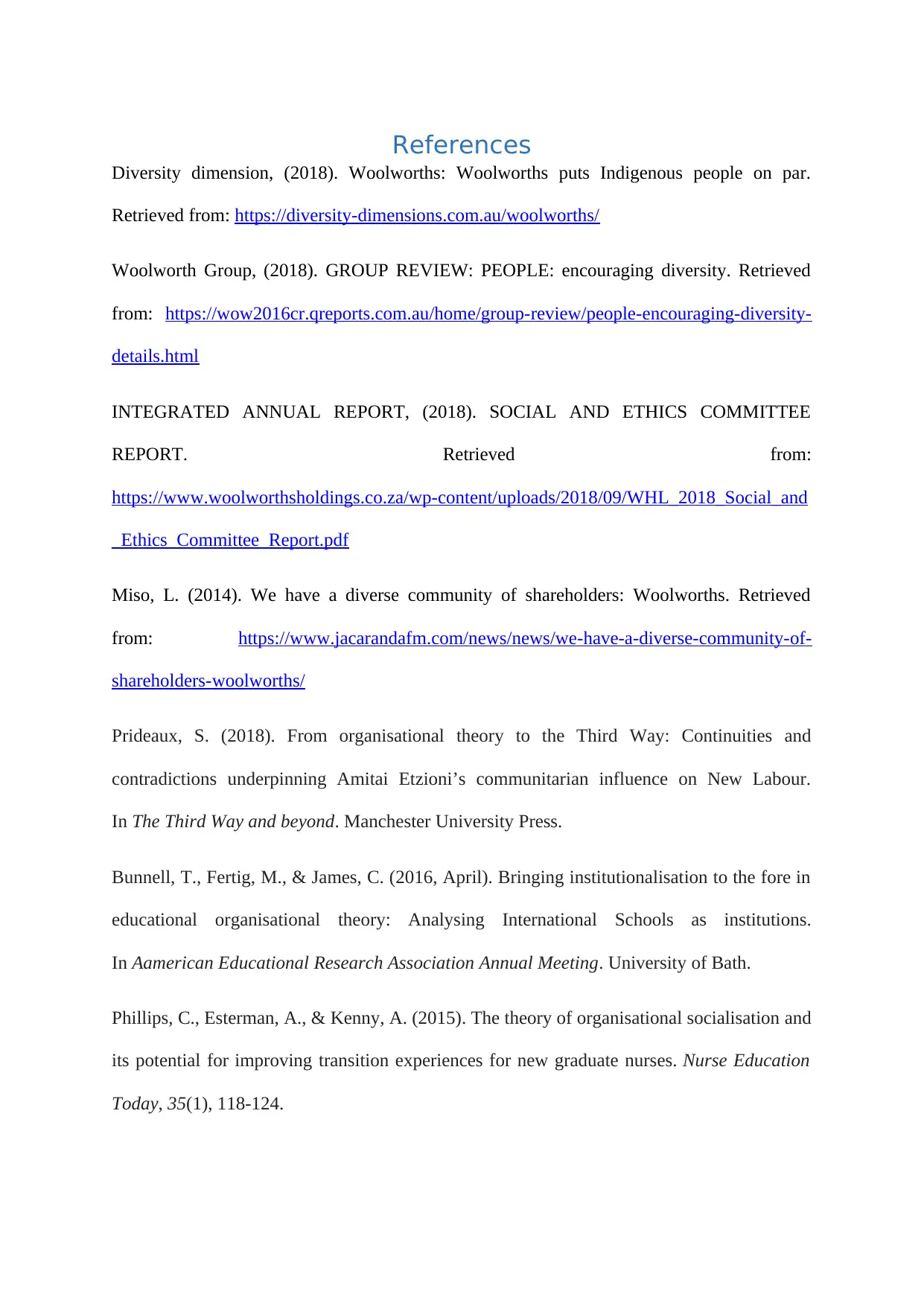
References
Diversity dimension, (2018). Woolworths: Woolworths puts Indigenous people on par.
Retrieved from: https://diversity-dimensions.com.au/woolworths/
Woolworth Group, (2018). GROUP REVIEW: PEOPLE: encouraging diversity. Retrieved
from: https://wow2016cr.qreports.com.au/home/group-review/people-encouraging-diversity-
details.html
INTEGRATED ANNUAL REPORT, (2018). SOCIAL AND ETHICS COMMITTEE
REPORT. Retrieved from:
https://www.woolworthsholdings.co.za/wp-content/uploads/2018/09/WHL_2018_Social_and
_Ethics_Committee_Report.pdf
Miso, L. (2014). We have a diverse community of shareholders: Woolworths. Retrieved
from: https://www.jacarandafm.com/news/news/we-have-a-diverse-community-of-
shareholders-woolworths/
Prideaux, S. (2018). From organisational theory to the Third Way: Continuities and
contradictions underpinning Amitai Etzioni’s communitarian influence on New Labour.
In The Third Way and beyond. Manchester University Press.
Bunnell, T., Fertig, M., & James, C. (2016, April). Bringing institutionalisation to the fore in
educational organisational theory: Analysing International Schools as institutions.
In Aamerican Educational Research Association Annual Meeting. University of Bath.
Phillips, C., Esterman, A., & Kenny, A. (2015). The theory of organisational socialisation and
its potential for improving transition experiences for new graduate nurses. Nurse Education
Today, 35(1), 118-124.
Diversity dimension, (2018). Woolworths: Woolworths puts Indigenous people on par.
Retrieved from: https://diversity-dimensions.com.au/woolworths/
Woolworth Group, (2018). GROUP REVIEW: PEOPLE: encouraging diversity. Retrieved
from: https://wow2016cr.qreports.com.au/home/group-review/people-encouraging-diversity-
details.html
INTEGRATED ANNUAL REPORT, (2018). SOCIAL AND ETHICS COMMITTEE
REPORT. Retrieved from:
https://www.woolworthsholdings.co.za/wp-content/uploads/2018/09/WHL_2018_Social_and
_Ethics_Committee_Report.pdf
Miso, L. (2014). We have a diverse community of shareholders: Woolworths. Retrieved
from: https://www.jacarandafm.com/news/news/we-have-a-diverse-community-of-
shareholders-woolworths/
Prideaux, S. (2018). From organisational theory to the Third Way: Continuities and
contradictions underpinning Amitai Etzioni’s communitarian influence on New Labour.
In The Third Way and beyond. Manchester University Press.
Bunnell, T., Fertig, M., & James, C. (2016, April). Bringing institutionalisation to the fore in
educational organisational theory: Analysing International Schools as institutions.
In Aamerican Educational Research Association Annual Meeting. University of Bath.
Phillips, C., Esterman, A., & Kenny, A. (2015). The theory of organisational socialisation and
its potential for improving transition experiences for new graduate nurses. Nurse Education
Today, 35(1), 118-124.
Paraphrase This Document
Need a fresh take? Get an instant paraphrase of this document with our AI Paraphraser
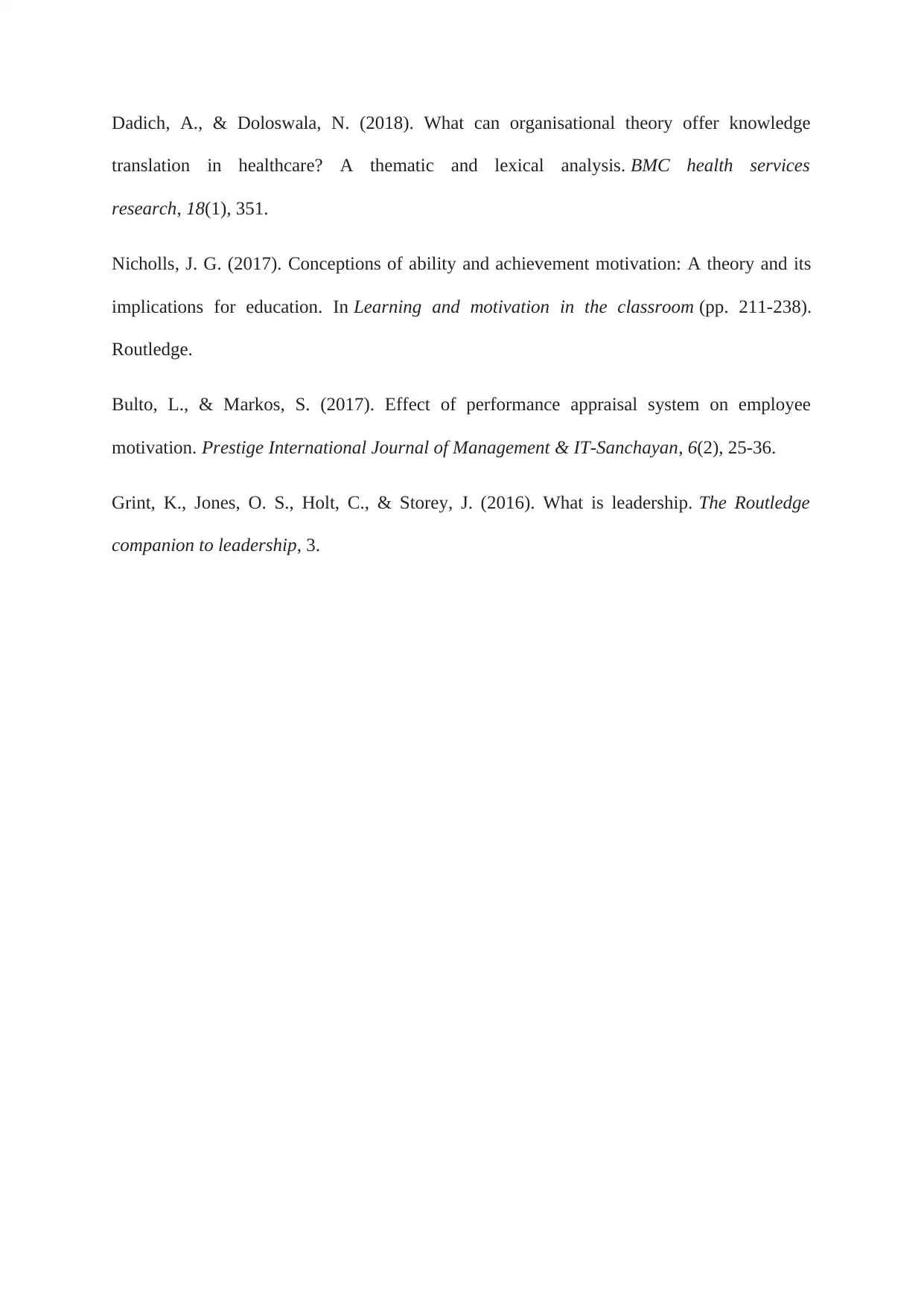
Dadich, A., & Doloswala, N. (2018). What can organisational theory offer knowledge
translation in healthcare? A thematic and lexical analysis. BMC health services
research, 18(1), 351.
Nicholls, J. G. (2017). Conceptions of ability and achievement motivation: A theory and its
implications for education. In Learning and motivation in the classroom (pp. 211-238).
Routledge.
Bulto, L., & Markos, S. (2017). Effect of performance appraisal system on employee
motivation. Prestige International Journal of Management & IT-Sanchayan, 6(2), 25-36.
Grint, K., Jones, O. S., Holt, C., & Storey, J. (2016). What is leadership. The Routledge
companion to leadership, 3.
translation in healthcare? A thematic and lexical analysis. BMC health services
research, 18(1), 351.
Nicholls, J. G. (2017). Conceptions of ability and achievement motivation: A theory and its
implications for education. In Learning and motivation in the classroom (pp. 211-238).
Routledge.
Bulto, L., & Markos, S. (2017). Effect of performance appraisal system on employee
motivation. Prestige International Journal of Management & IT-Sanchayan, 6(2), 25-36.
Grint, K., Jones, O. S., Holt, C., & Storey, J. (2016). What is leadership. The Routledge
companion to leadership, 3.
1 out of 11
Related Documents
Your All-in-One AI-Powered Toolkit for Academic Success.
+13062052269
info@desklib.com
Available 24*7 on WhatsApp / Email
![[object Object]](/_next/static/media/star-bottom.7253800d.svg)
Unlock your academic potential
Copyright © 2020–2025 A2Z Services. All Rights Reserved. Developed and managed by ZUCOL.





